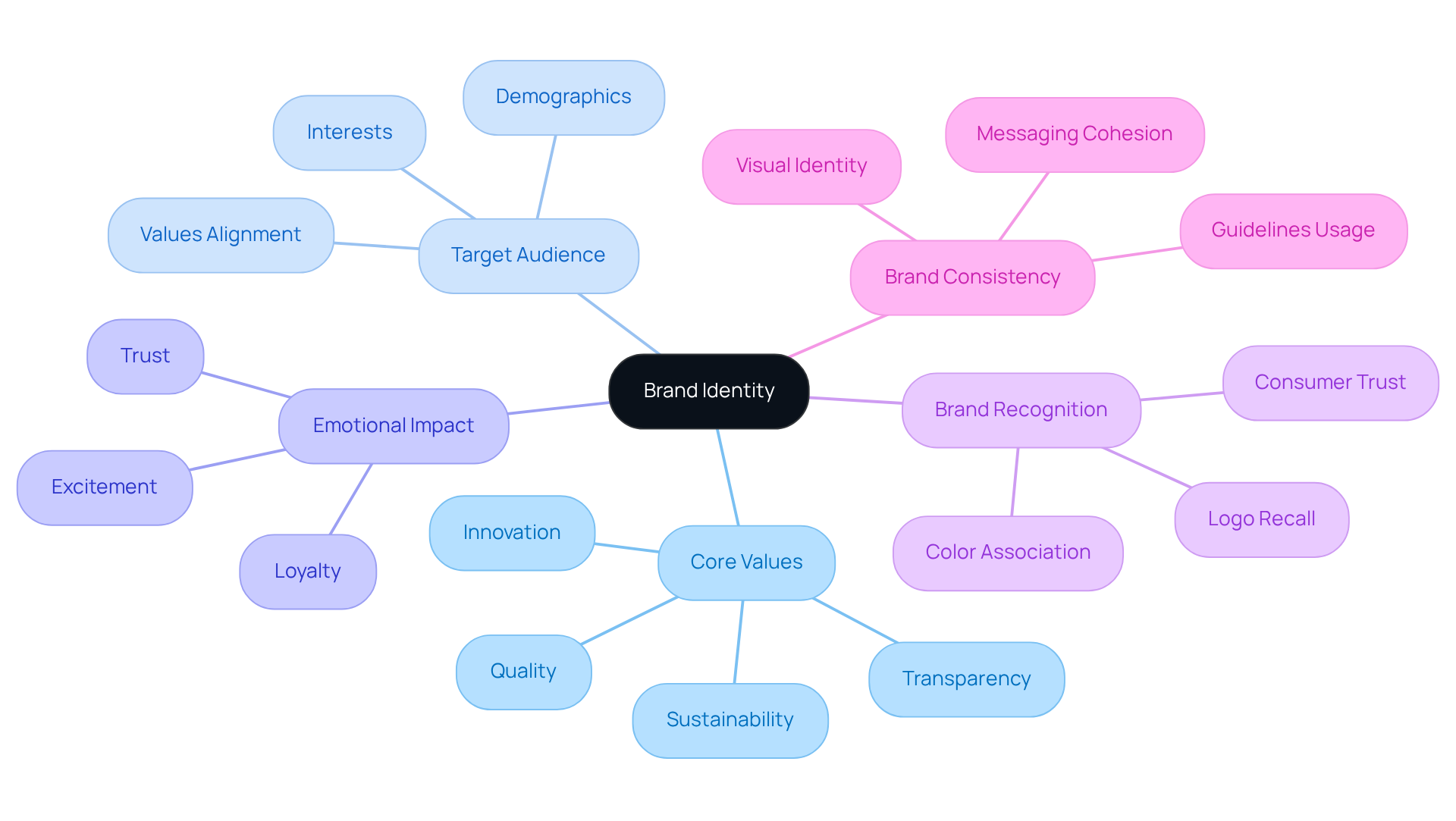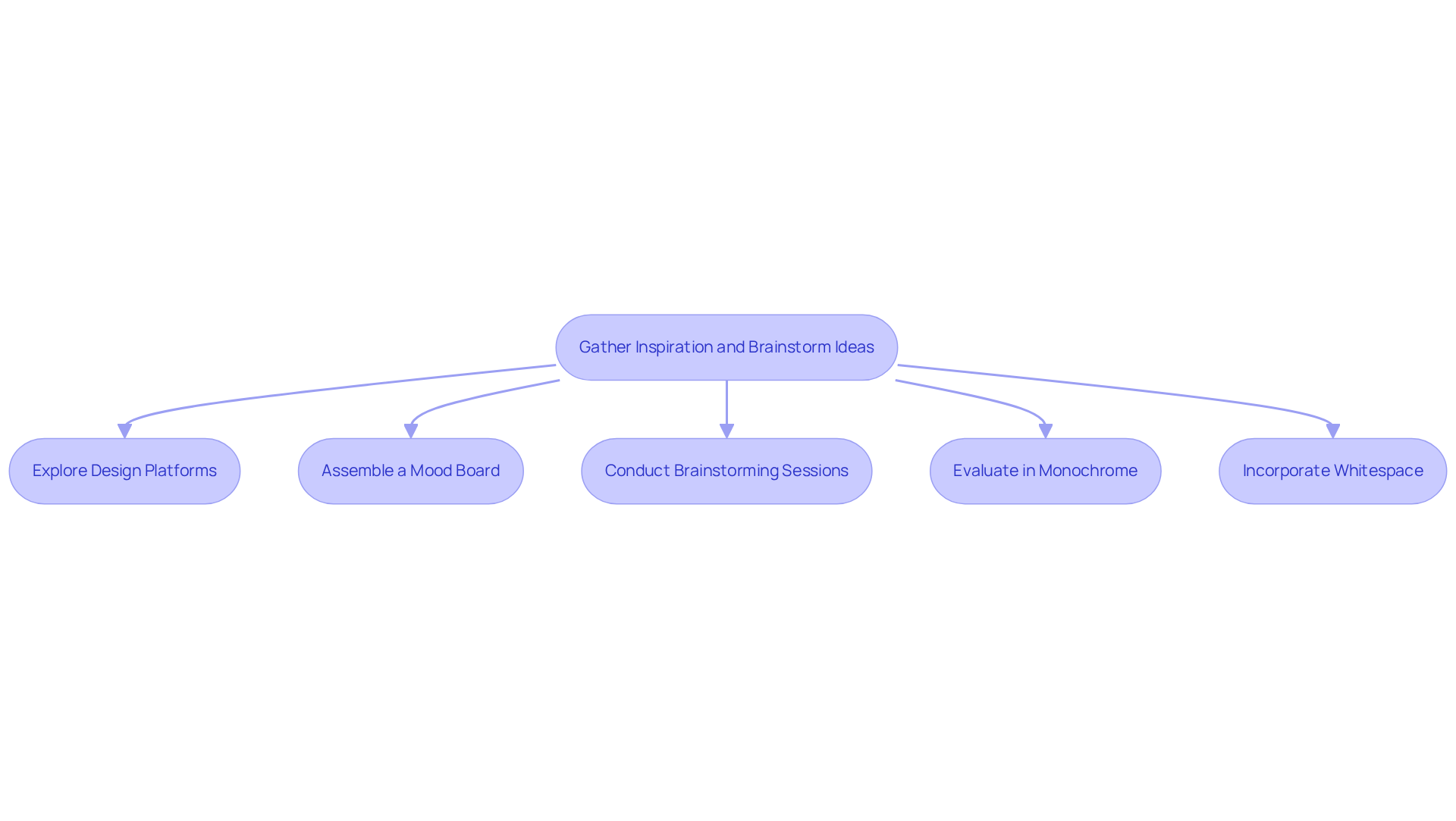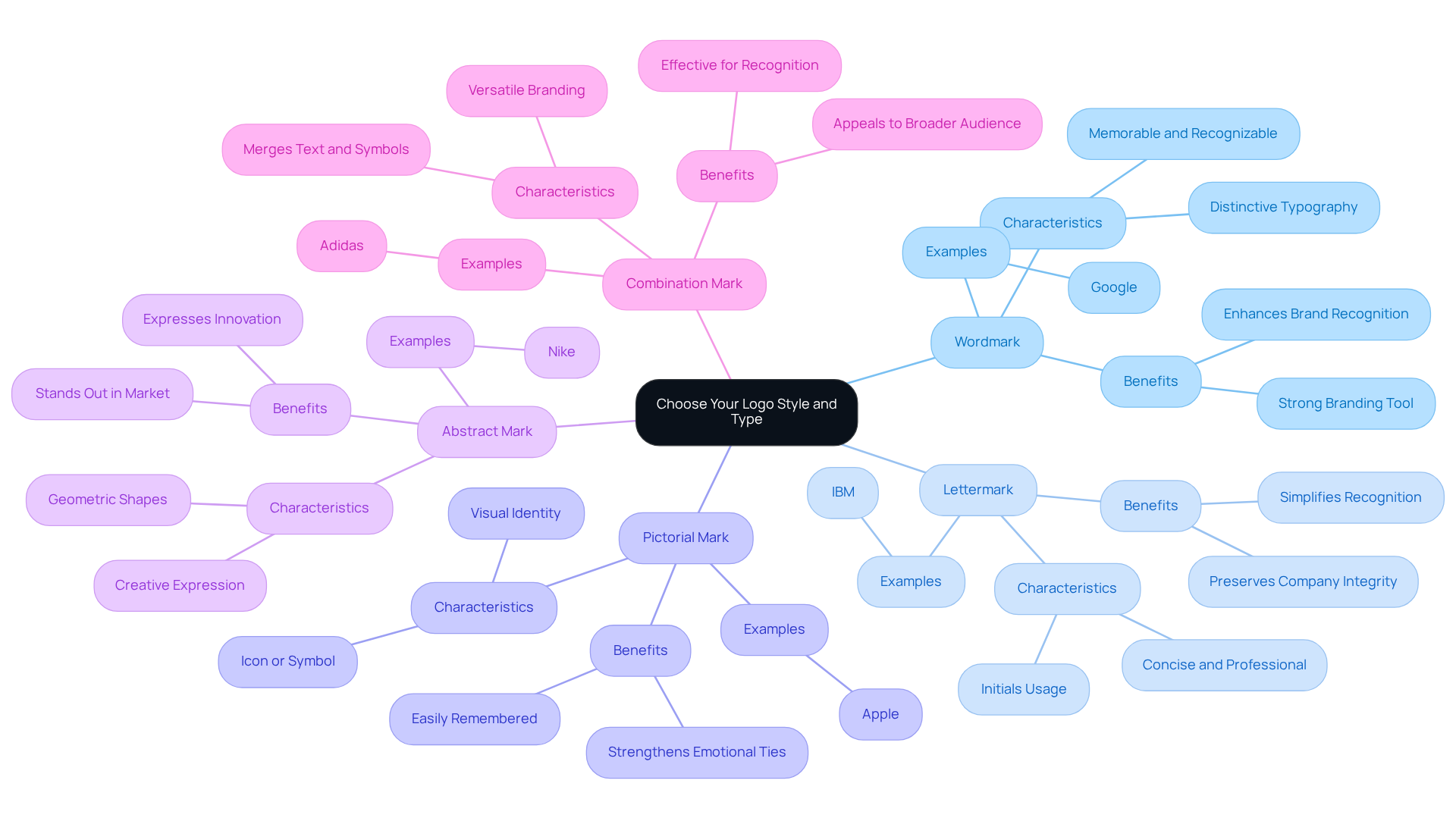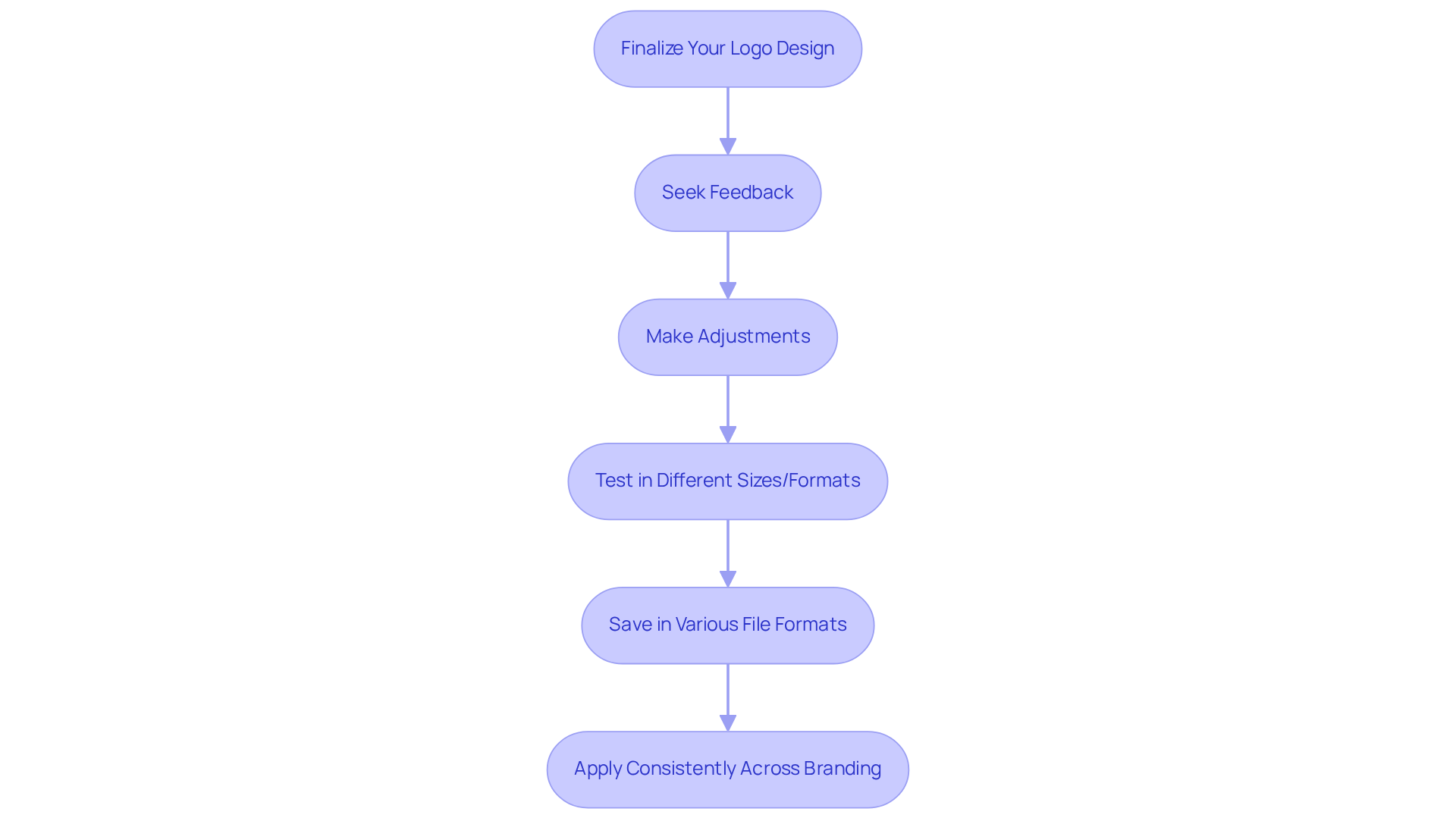Overview
Creating a compelling brand logo can feel overwhelming for many tech startup founders. It’s not just about aesthetics; it’s about capturing the essence of your brand. Without a clear brand identity, you might struggle to connect with your audience, leaving your vision unrecognized and your efforts unnoticed. This can be disheartening, especially when you pour your heart and soul into your venture.
The process involves five essential steps:
- Defining your brand identity, which lays the foundation for everything that follows.
- Gathering inspiration helps you visualize what resonates with you and your audience.
- Choosing your logo style and type is where creativity meets strategy, ensuring your logo stands out.
- Selecting colors and typography adds personality, evoking emotions that can foster connections.
- Finalizing and applying your logo brings your vision to life, making it a tangible representation of your brand.
Each step is crucial, as it ensures your logo effectively represents your brand's core values. It’s about more than just a design; it’s about resonating with your target audience and enhancing recognition. When done thoughtfully, your logo can drive consumer loyalty and engagement, creating a lasting emotional connection. Remember, you’re not alone in this journey. We’re here to support you every step of the way, helping you create a logo that truly reflects your passion and purpose.
Introduction
Creating a brand logo is more than just a design task; it serves as the visual cornerstone of a company's identity. Many entrepreneurs face the daunting challenge of crafting a logo that not only stands out but also resonates with their target audience. This struggle can feel overwhelming, as a compelling logo encapsulates a brand's mission, values, and personality, making it essential for establishing a strong market presence.
How can one navigate this intricate process of logo creation? It's crucial to ensure that the logo effectively communicates the essence of their brand while fostering recognition and loyalty.
At RNO1, we understand these complexities and are here to guide you through the journey of logo creation with empathy and expertise.
Define Your Brand Identity
Begin by clearly defining your organization's mission and vision. This foundational step can feel overwhelming, but it is essential for the success of your brand logo. Consider these important questions:
- What core values define your brand?
- Who is your target audience?
- What feelings do you want your identity to evoke?
By reflecting on these queries, you can create a character that embodies these elements, serving as a strong foundation for your design choices. For instance, if your company emphasizes innovation and technology, your emblem should express modernity and a forward-looking ethos.
Many startups struggle with identity creation, often feeling lost in a crowded marketplace. Successful examples like Apple and Tesla show us the power of a strong identity in digital marketing. Their logos reflect a commitment to innovation and sustainability, resonating deeply with consumers. Research indicates that 62% of consumers favor companies prioritizing sustainability, highlighting the profound influence a strong mission has on consumer perception.
Furthermore, a clearly articulated mission and vision can significantly affect how consumers view your identity. In fact, 81% of consumers indicate that confidence in a company is a deciding factor in their purchasing choices. This underscores the necessity of aligning your company's core values and mission with your brand logo design. By doing so, you not only enhance recognition—75% of consumers remember a company by its brand logo—but also foster a deeper emotional connection with your audience, ultimately driving loyalty and engagement.
At RNO1, we deeply understand the importance of these elements in establishing a captivating identity. Our strategic alliances, including those with Microsoft and the EOS Network Foundation, reflect our commitment to advancing digital innovation. Through , we empower contemporary companies to achieve radical digital experiences across platforms, ensuring that their logos and overall identity resonate with their target audiences. By maximizing brand marketability through our Return On Design & Digital (RODD) strategies, we help brands like Founder's Haven redefine their identity for digital success. Our creation methodologies focus on crafting impactful visual stories that align with our clients' missions and values, nurturing a supportive environment for growth and connection.

Gather Inspiration and Brainstorm Ideas
Embarking on your design journey can feel overwhelming, especially when searching for inspiration. It’s common to feel lost amidst countless options. Start by exploring popular design platforms like Dribbble, Behance, and Pinterest. These platforms can spark your creativity and help you gather visual inspiration. As you gather ideas, consider assembling a mood board that captures the essence of your brand. Include:
- A brand logo that reflects your identity
- Color palettes that evoke the emotions you wish to convey—remember, color can enhance brand recognition by up to 16%
- Typography styles that resonate with your brand voice
Engaging in brainstorming sessions, whether alone or with your team, can be incredibly beneficial for cultivating ideas. Techniques such as mind mapping or sketching can help visualize concepts and bring your thoughts to life. Don’t shy away from unconventional ideas; often, the most unique symbols emerge from surprising origins. It’s important to remember that 94% of initial perceptions about a company are influenced by the brand logo, making this initial phase crucial for establishing a strong visual identity.
As you develop your design, consider evaluating it in monochrome. This approach ensures that your design , independent of color. Additionally, incorporating whitespace effectively can enhance the balance and clarity of your design, aligning your choices with the essence and message of your organization. By nurturing your design process and remaining open to inspiration, you can create a visual identity that truly represents your brand and resonates with your audience.

Choose Your Logo Style and Type
When selecting a logo style, many founders face the challenge of making their brand logo stand out in a crowded marketplace. This decision can feel overwhelming, especially when considering how crucial a brand logo is for recognition and connection with your audience. At RNO1, we understand this struggle and are here to guide you through it.
Wordmark: This style emphasizes your brand name through distinctive typography, making it memorable and easily recognizable. Companies like Google exemplify this approach, leveraging their name as a powerful branding tool. A well-designed wordmark, combined with a strong brand logo, can significantly enhance recognition, highlighting its importance in creating a strong presence. We believe that a design-focused wordmark can greatly influence your company's marketability through our RODD strategies.
Lettermark: Using initials, lettermarks (like IBM) create a concise and professional image, perfect for companies with longer names. This style simplifies recognition while preserving your company’s integrity, making it effective for those aiming for a sleek and modern image. Our design-driven solutions can help you craft a lettermark that resonates with your audience and aligns with our RODD strategies.
Pictorial Mark: Incorporating an icon or symbol, pictorial marks (such as Apple) convey identity visually. This style can strengthen emotional ties with consumers, as symbols that evoke feelings are more likely to be remembered. As Manisha Saini noted, '75% of consumers identify a label by its brand logo,' emphasizing the significance of this style. We focus on that align with your company’s vision and values, utilizing our RODD strategies to maximize impact.
Abstract Mark: Utilizing geometric shapes, abstract marks (like Nike) provide a distinctive portrayal of identity, enabling creative expression that stands out in a saturated market. This style is especially effective for companies aiming to express innovation and modernity, which is a core principle of our philosophy and RODD strategies.
Combination Mark: This versatile style merges text and symbols (like Adidas), offering flexibility in branding. Combination marks are effective for building recognition, leveraging both visual and textual elements to appeal to a broader audience. Our method ensures that your combination mark is effective through careful planning and our RODD strategies.
To find the style that best corresponds with your identity, reflect on how each option connects with your target audience. Consider current trends, such as the growing appeal of minimalistic aesthetics and environmentally friendly themes. Research shows that 70% of younger consumers favor eco-conscious symbols featuring minimalist styles. Moreover, companies embracing responsive logos have seen a 15% rise in user engagement, underscoring the importance of flexibility in creativity. At RNO1, we prioritize these trends to enhance your company’s marketability through our Return On Design & Digital (RODD) strategies.
Sketch potential designs in your chosen style to visualize their impact. Remember, a well-crafted brand logo can significantly enhance recognition, making this decision crucial for your company’s success. We are here to support you every step of the way.

Select Colors and Typography
Selecting a color palette that truly reflects your organization's personality is not just a choice; it’s a vital step in establishing your identity. Many founders struggle with this decision, feeling overwhelmed by the psychological impact colors can have on their audience. For instance, consider the calming nature of blue, which conveys trust and professionalism. This makes it a great choice for tech startups aiming to establish credibility. Research indicates that blue is associated with trust, professionalism, cleanliness, and calmness—qualities that can significantly influence how consumers perceive your brand logo.
On the other hand, red symbolizes energy and passion. If your company seeks to evoke excitement, red might be the color for you. Brian Lischer highlights that red is the most emotionally charged color, intensifying reactions and drawing attention in a crowded marketplace. Meanwhile, green represents growth and health, making it perfect for companies focused on sustainability or wellness. This color resonates well with audiences who prioritize environmental responsibility, reflecting your commitment to a better future.
Yellow, linked to optimism and creativity, can invigorate your image, but it’s important to use it wisely. Overusing yellow can be overwhelming, so consider how it fits into your overall palette.
When it comes to typography, ensure that it complements your logo style and enhances legibility while aligning with your voice. For example, a tech startup may thrive with a modern sans-serif typeface that conveys innovation, while a luxury brand might opt for an elegant serif typeface to reflect sophistication. Experimenting with different combinations can help you discover what aligns best with your company's image, all while keeping current trends in mind to maintain relevance and attraction.
Consistency in applying your brand logo colors across all platforms is essential. It can enhance the effectiveness of your marketing efforts and create a cohesive experience centered around your brand logo. As Brian Lischer emphasizes, selecting a color that is true to your identity, embodies your essence, appeals to your audience, and distinguishes your company from the competition is one of the best ways to create a powerful and meaningful visual identity. Remember, this journey is about more than just colors; it’s about creating a connection with your audience and fostering a sense of community around your brand logo.

Finalize and Apply Your Logo
Once you have a design you love, the next step is to refine it by seeking feedback from peers or potential customers. This input is invaluable; did you know that as a key factor in their choices? This statistic highlights just how significant feedback is in symbol development. Make the necessary adjustments based on their input. It's essential to ensure your brand logo is versatile, so take the time to test it in different sizes and formats. Consider how it looks on business cards, websites, and social media profiles. Research indicates that businesses effectively utilizing their symbols on social media platforms witness a 13% increase in brand awareness. Additionally, think about developing variations of your emblem for various uses, such as a simplified version for smaller sizes.
Finally, remember to save your design in various file formats, like PNG, SVG, and JPEG, to guarantee it can be used across different platforms. By 2024, it's projected that 70% of new emblems will be created with social media in mind, which emphasizes the importance of considering digital platforms in your design process. Consistency is key—apply your brand logo uniformly across all branding materials to enhance recognition and trust. Consistent brand presentation can increase revenue by up to 23%, so it’s worth the effort to get it right.

Conclusion
Creating a compelling brand logo can often feel overwhelming for many founders. It's a multifaceted journey that begins with understanding your brand identity and culminates in a design that truly resonates with your audience. By clearly defining your mission, values, and target audience, you lay a strong foundation for the design process. This clarity not only enhances recognition but also fosters an emotional connection with consumers, which is vital in today’s competitive landscape.
As you navigate this journey, it’s essential to recognize the key steps involved—from gathering inspiration and brainstorming ideas to selecting the right logo style, colors, and typography. Each of these elements plays a crucial role in shaping a visual identity that is not only memorable but also reflective of your brand’s essence. The importance of feedback in refining your logo and ensuring its versatility across various platforms cannot be overstated. This feedback significantly impacts brand perception and engagement, and it’s a step that shouldn’t be overlooked.
Ultimately, designing a logo transcends mere aesthetics; it’s about building a strong, authentic connection with your audience. By investing time and effort into each step, you can create logos that not only stand out but also effectively convey your core values. Embracing these strategies will empower you to craft logos that capture attention and foster loyalty and engagement in the long run. Remember, you are not alone in this journey—many have faced similar challenges and emerged with logos that tell their unique stories. Together, we can navigate this process and create something truly special.
Frequently Asked Questions
What is the first step in defining a brand identity?
The first step is to clearly define your organization's mission and vision, which serves as a foundation for your brand logo.
What questions should I consider when defining my brand identity?
Consider the following questions: What core values define your brand? Who is your target audience? What feelings do you want your identity to evoke?
Why is it important to have a strong brand identity?
A strong brand identity helps differentiate your company in a crowded marketplace and can significantly influence consumer perception and loyalty.
How do successful brands like Apple and Tesla exemplify strong brand identities?
Brands like Apple and Tesla reflect a commitment to innovation and sustainability in their logos, resonating deeply with consumers and enhancing their market presence.
What impact does a clearly articulated mission and vision have on consumer behavior?
A clearly articulated mission and vision can significantly affect consumer confidence, with 81% of consumers indicating it influences their purchasing choices.
How can I gather inspiration for my brand logo design?
You can gather inspiration by exploring popular design platforms like Dribbble, Behance, and Pinterest, and by creating a mood board that captures your brand's essence.
What elements should I include in my mood board?
Include a brand logo that reflects your identity, color palettes that evoke desired emotions, and typography styles that resonate with your brand voice.
What techniques can help in brainstorming logo ideas?
Techniques such as mind mapping and sketching can help visualize concepts and bring your ideas to life.
Why is evaluating a design in monochrome important?
Evaluating a design in monochrome ensures that it retains its character and impact, regardless of color.
How does whitespace affect logo design?
Incorporating whitespace effectively enhances the balance and clarity of your design, aligning it with your organization's essence and message.




